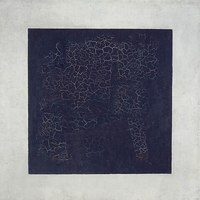- Physical-item (Artwork 2D)
- Αντικείμενο
- 1915
- Kazimir Malevich (1879 - 1935)
- Paintings
- Geometry | Painting | Arts
- Oil on canvas | 79.5 x 79.5 cm
- Public Domain Mark
-
- Πρωτότυπο
-
-
Black Square (Russian Чёрный квадрат) is a 1915 oil on linen canvas painting by the artist Kazimir Malevich The first of four painted versions, the original was completed in 1915 and described by the artist as his breakthrough work and the inception for the launch of his Suprematist art movement (1915–1919).[1]
⟶ Wikipedia, Wikimedia Commons -
On 19 December 1915, “The Last Futuristic Exhibition 0.10” opened in Petrograd, where fourteen Russian avant-garde artists were brought together. Malevich presented 39 works at the exhibition, including the “Black Square” that was placed in the “red corner” (like an icon). It became a declaration in colour and form of Suprematism (from the Latin supreme, the highest), the new art trend invented by Malevich.
The Quadrangle was the original name for the “Black Square” as it was listed in the catalog. Without any strictly right angles, from the point of view of pure geometry, it really was a quadrangle; it was the artist’s position of principle and desire to create a dynamic, mobile form, rather than negligence.
In 2015, the Tretyakov Gallery performed a comprehensive study of the “Black Square”. Two multi-figured geometric compositions were discovered under a layer of paint, over the top of which the “Black Square” was eventually painted.
The artist also painted replicas of the “Square”: the second was painted in the spring of 1924 for the 14th Venice Biennale, the third in 1929 for a solo exhibition at the Tretyakov Gallery, and the fourth “Black Square” appeared in the early 1930s. The later works differed from the 1915 originals in size and proportions; Malevich did not seek precise replication.
⟶ Tretyakov Gallery
-
- Tretyakov Gallery | Wikimedia Commons
- State Tretyakov Gallery, Moscow, Russia




